MaryAnn Bernal's Blog, page 216
November 26, 2014
Buried Polish 'Vampires' Likely Had Cholera

A 30-39 year old "vampire" female, buried with a sickle placed across the neck.
by Rossella Lorenzi
News Discovery
“Vampires” buried in northwestern Poland with large stones wedged into their mouths or sickles over their necks were local people probably affected by cholera, says the first biogeochemical study of human skeletal remains from deviant burials.
The study investigated 285 human skeletons which were excavated between 2008-2012 from a post medieval cemetery in Drawsko, a rural settlement site in northwestern Poland. Dating to the 17th and 18th centuries, the remains represented individuals of all ages and both sexes.
Among the interments, six were identified as so-called vampire burials. They included an adult male, a late adolescent female, three adult females, and a younger person of unknown sex.
“Of these six individuals, five were interred with a sickle placed across the throat or abdomen, intended to remove the head or open the gut should they attempt to rise from the grave,” Lesley Gregoricka from University of South Alabama and colleagues, wrote in the open-access journal PLOS ONE.
The remaining two people were found with large stones positioned beneath their chins -- evidence, the researchers say, that it was feared the individuals would rise from their graves to bite others.
Gregoricka and colleagues first hypothesized the people buried as vampires were targeted because of their outsider status as immigrants.
Indeed, abundant written evidence for the post-medieval period describes many waves of immigrants entering into Poland during that time.
To test their hypothesis, the researchers tested permanent molars from 60 individuals, including the six "vampires,” using radiogenic strontium isotope ratios from archaeological dental enamel. Local animals, including hare, mice and fox, were also sampled.
“While historic records describe the many potential reasons why some people were considered at increased risk of becoming a vampire, no previous study had attempted to examine the identity of these individuals using chemical analyses of the human skeleton,” Gregoricka told Discovery News.
Strontium isotopes incorporated into teeth during growth and development can tell about the place someone grew up, whether the individual moved later and whether the person was buried somewhere different from where they spent their childhood.
"Contrary to our hypothesis, we found that all of the vampires were local," Gregoricka said.
"We actually found others in the cemetery that were non-local to the region, but were not buried as vampires," she added.
According to the researchers, there should be another reason for the deviant burials, since the targeted individuals were not suspected of becoming vampires due to their identity as non-locals.
Gregoricka and colleagues propose cholera epidemics as an alternative explanation.
Multiple waves of cholera epidemics struck Europe during the post-medieval period, but people were unaware that cholera was a bacteria spread through contaminated drinking water.
“There was no scientific understanding of how infectious disease was spread. Instead, because they couldn’t explain it, they attributed cholera to the supernatural -- specifically, to vampires,” Gregoricka said.
In this view, the first person to die in an epidemic was thought to seek revenge on the living by returning from the grave to inflict the illness upon others, causing the disease to spread.
“As such, if these six individuals were the first to die in a series of cholera outbreaks that affected Drawsko during the post-medieval period, they may have been buried in this way as a means of preventing them from returning as vampires and attacking the living,” Gregoricka said.
“Disease is often discussed as a possible cause for deviant burials in Europe," said biological anthropologist Kristina Killgrove. "In the case of these post-medieval Polish burials, cholera certainly could be an explanation."
“Unfortunately, cholera leaves no marks on bone, so it's not possible to tell by looking at the skeletons whether or not they suffered from the disease,” she added.

Published on November 26, 2014 14:20
History Trivia - Danish Vikings attack Paris
November 26

579 Pelagius II became Pope. When assistance from Emperor Tiberius II of Byzantium was not forthcoming, Pelagius convinced the Christian Franks to defend Rome from encroaching Lombards. He attempted to end a schism in the Church over the Three Chapters Controversy and began a controversy of his own when St. John IV the Faster, Bishop of Constantinople, assumed the title of "ecumenical patriarch" (a position that made him the equal of Pelagius, if not his superior). Pelagius was also responsible for building projects in Rome and turned his home into a hospital that was of great assistance when the city was struck by a disastrous flood. He himself died of the plague. 7

885 Danish Vikings attacked Paris and were paid by the Frankish emperor Charles the Fat not to destroy the city as they had in 845 and 856.
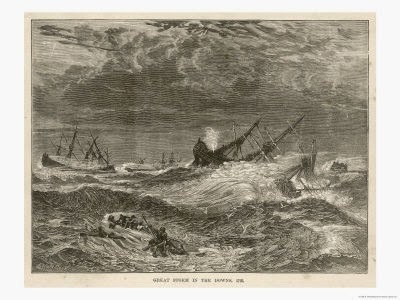
1703 Hurricane-force winds killed as many as 8,000 people as the Great Storm swept southern England. Bristol incurred heavy damage and the Royal Navy lost 15 warships.


579 Pelagius II became Pope. When assistance from Emperor Tiberius II of Byzantium was not forthcoming, Pelagius convinced the Christian Franks to defend Rome from encroaching Lombards. He attempted to end a schism in the Church over the Three Chapters Controversy and began a controversy of his own when St. John IV the Faster, Bishop of Constantinople, assumed the title of "ecumenical patriarch" (a position that made him the equal of Pelagius, if not his superior). Pelagius was also responsible for building projects in Rome and turned his home into a hospital that was of great assistance when the city was struck by a disastrous flood. He himself died of the plague. 7

885 Danish Vikings attacked Paris and were paid by the Frankish emperor Charles the Fat not to destroy the city as they had in 845 and 856.

1703 Hurricane-force winds killed as many as 8,000 people as the Great Storm swept southern England. Bristol incurred heavy damage and the Royal Navy lost 15 warships.

Published on November 26, 2014 05:38
November 25, 2014
Mysterious Roman God Baffles Experts
by Tia Ghose
Live Science
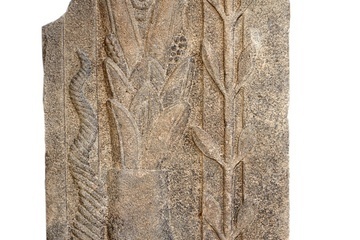
An unknown Roman god was recently unearthed at a sanctuary in southeast Turkey. The god, who is emerging from a plant, is depicted with both Near Eastern and Roman elements, and may have been a baal, or subdeity, of the temple's major god, Jupiter Dolichenus
Credit: Peter JülichA sculpture of a mysterious, never-before-seen Roman deity has been unearthed in an ancient temple in Turkey.
The 1st century B.C. relief, of an enigmatic bearded god rising up out of a flower or plant, was discovered at the site of a Roman temple near the Syrian border. The ancient relief was discovered in a supporting wall of a medieval Christian monastery.
"It's clearly a god, but at the moment it's difficult to say who exactly it is," said Michael Blömer, an archaeologist at the University of Muenster in Germany, who is excavating the site. "There are some elements reminiscent of ancient Near Eastern gods, as well, so it might be some very old god from before the Romans." [See Images of the Mysterious Roman God]
The ancient Roman god is a complete mystery; more than a dozen experts contacted by Live Science had no idea who the deity was.
Cultural crossroads
The temple sits on a mountaintop near the modern town of Gaziantep, above the ancient city of Doliche, or Dülük. The area is one of the oldest continuously settled regions on Earth, and for millennia, it was at the crossroads of several different cultures, from the Persians to the Hittites to the Arameans. During the Bronze Age, the city was on the road between Mesopotamia and the ancient Mediterranean.
In 2001, when Blömer's team first began excavating at the site, almost nothing was visible from the surface. Through years of painstaking excavation, the team eventually discovered the ruins of an ancient Bronze Age structure as well as a Roman Era temple dedicated to Jupiter Dolichenus, a Romanized version of the ancient Aramean sky or storm god, who headed the Near Eastern pantheon, Blömer said.
During the second and third centuries A.D., the cult of Jupiter Dolichenus became a global religion likely because many Roman soldiers were recruited from the area where he was worshipped, and those soldiers took their god with them, said Gregory Woolf, a classicist at the University of St. Andrews in Scotland, who was not involved in the excavation.
After the temple was destroyed, medieval Christians built the Mar Solomon monastery on the foundation of the site, and after the Crusades, the site became the burial place of a famous Islamic saint.
Blömer's team was excavating one of the old buttress walls of the Mar Solomon monastery when they discovered the relief, which had been plastered over.
The relief depicted a bearded man rising up out of a palm-type plant while holding the stalk of another. The bottom of the relief contains images of a crescent, a rosette and a star. The top of the relief was broken off but when it was complete it would have stood about the size of a human being.
"It was quite a big surprise when we saw the relief coming out of in this area of the site," Blömer told Live Science.
Unknown deity
The mysterious deity may have been a Roman spin on a local Near Eastern god, and the agricultural elements suggest a connection to fertility. But beyond that, the deity's identity has stumped experts.
The relief shows some elements associated with Mesopotamia. For instance, the rosette at the bottom may be associated with Ishtar, while the crescent moon at the base is a symbol of the moon god Sîn, Nicole Brisch, a Near Eastern studies expert at the University of Copenhagen in Denmark, wrote in an email. (Brisch was not involved in the current excavation.)
"The bottom bits are from the Near East and the top bits are classical," Woolf told Live Science. "He looks to me like he was somebody from a native, very local pantheon." [Images: Ancient Carving of Roman God]
The fact that he is rising out of a plant is reminiscent of the birth myths of some gods, such as the mystery cult god Mithras, who was born from a rock, or the Greek goddess Aphrodite, who was born out of sea foam, Woolf speculated.
Mashup god
Though the gods' identity is a mystery, the hybridization of gods isn't unusual for the time, Woolf said.
"When the dominant style in the area is Greek and Roman, they give their gods a face-lift," Woolf told Live Science.
For instance, the ancient Egyptian gods end up wearing the clothes of Roman legionaries, and ancient Mesopotamian gods, which were typically depicted as "betels" — stones or meteorites — get human faces, Woolf said.
The best chances of identifying this enigmatic deity is to find a similar representation somewhere with an inscription describing who he was, Woolf said. But getting the word out could also help. Sometimes findings get widely disseminated and "someone turns up a little object that they've had in their private collection and say, 'Do you know, I think this is the same person,'" Woolf said.

Live Science

An unknown Roman god was recently unearthed at a sanctuary in southeast Turkey. The god, who is emerging from a plant, is depicted with both Near Eastern and Roman elements, and may have been a baal, or subdeity, of the temple's major god, Jupiter Dolichenus
Credit: Peter JülichA sculpture of a mysterious, never-before-seen Roman deity has been unearthed in an ancient temple in Turkey.
The 1st century B.C. relief, of an enigmatic bearded god rising up out of a flower or plant, was discovered at the site of a Roman temple near the Syrian border. The ancient relief was discovered in a supporting wall of a medieval Christian monastery.
"It's clearly a god, but at the moment it's difficult to say who exactly it is," said Michael Blömer, an archaeologist at the University of Muenster in Germany, who is excavating the site. "There are some elements reminiscent of ancient Near Eastern gods, as well, so it might be some very old god from before the Romans." [See Images of the Mysterious Roman God]
The ancient Roman god is a complete mystery; more than a dozen experts contacted by Live Science had no idea who the deity was.
Cultural crossroads
The temple sits on a mountaintop near the modern town of Gaziantep, above the ancient city of Doliche, or Dülük. The area is one of the oldest continuously settled regions on Earth, and for millennia, it was at the crossroads of several different cultures, from the Persians to the Hittites to the Arameans. During the Bronze Age, the city was on the road between Mesopotamia and the ancient Mediterranean.
In 2001, when Blömer's team first began excavating at the site, almost nothing was visible from the surface. Through years of painstaking excavation, the team eventually discovered the ruins of an ancient Bronze Age structure as well as a Roman Era temple dedicated to Jupiter Dolichenus, a Romanized version of the ancient Aramean sky or storm god, who headed the Near Eastern pantheon, Blömer said.
During the second and third centuries A.D., the cult of Jupiter Dolichenus became a global religion likely because many Roman soldiers were recruited from the area where he was worshipped, and those soldiers took their god with them, said Gregory Woolf, a classicist at the University of St. Andrews in Scotland, who was not involved in the excavation.
After the temple was destroyed, medieval Christians built the Mar Solomon monastery on the foundation of the site, and after the Crusades, the site became the burial place of a famous Islamic saint.
Blömer's team was excavating one of the old buttress walls of the Mar Solomon monastery when they discovered the relief, which had been plastered over.
The relief depicted a bearded man rising up out of a palm-type plant while holding the stalk of another. The bottom of the relief contains images of a crescent, a rosette and a star. The top of the relief was broken off but when it was complete it would have stood about the size of a human being.
"It was quite a big surprise when we saw the relief coming out of in this area of the site," Blömer told Live Science.
Unknown deity
The mysterious deity may have been a Roman spin on a local Near Eastern god, and the agricultural elements suggest a connection to fertility. But beyond that, the deity's identity has stumped experts.
The relief shows some elements associated with Mesopotamia. For instance, the rosette at the bottom may be associated with Ishtar, while the crescent moon at the base is a symbol of the moon god Sîn, Nicole Brisch, a Near Eastern studies expert at the University of Copenhagen in Denmark, wrote in an email. (Brisch was not involved in the current excavation.)
"The bottom bits are from the Near East and the top bits are classical," Woolf told Live Science. "He looks to me like he was somebody from a native, very local pantheon." [Images: Ancient Carving of Roman God]
The fact that he is rising out of a plant is reminiscent of the birth myths of some gods, such as the mystery cult god Mithras, who was born from a rock, or the Greek goddess Aphrodite, who was born out of sea foam, Woolf speculated.
Mashup god
Though the gods' identity is a mystery, the hybridization of gods isn't unusual for the time, Woolf said.
"When the dominant style in the area is Greek and Roman, they give their gods a face-lift," Woolf told Live Science.
For instance, the ancient Egyptian gods end up wearing the clothes of Roman legionaries, and ancient Mesopotamian gods, which were typically depicted as "betels" — stones or meteorites — get human faces, Woolf said.
The best chances of identifying this enigmatic deity is to find a similar representation somewhere with an inscription describing who he was, Woolf said. But getting the word out could also help. Sometimes findings get widely disseminated and "someone turns up a little object that they've had in their private collection and say, 'Do you know, I think this is the same person,'" Woolf said.

Published on November 25, 2014 16:11
Stone Age Axe Found Deliberately Stuck Into Earth
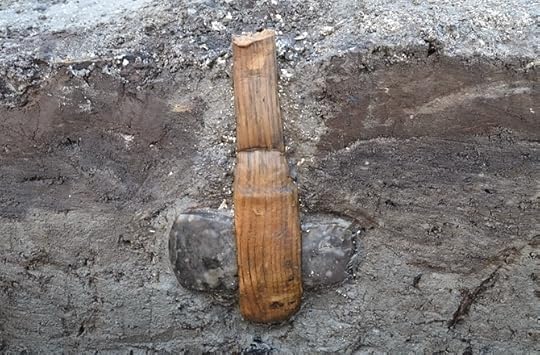
by Rossella Lorenzi
Discovery News
Archaeologists in southern Denmark have unearthed a 5,500-year-old axe with the handle still attached. The axe was deliberately jammed into what used to be the seabed during the Stone Age.
The finding was made during an archaeological survey for the construction of the Femern Belt link, an immersed tunnel that will connect the German island of Fehmarn with the Danish island of Lolland. Earlier this month, the same dig yielded 5,000-year-old footprints.
5,000-Year-Old Footprints Found in Denmark
“Axes are among the typical finds from the Stone Age, but in hafted form (attached to a handle), they are extremely rare,” Anne-Lotte Sjørup Mathiesen of the Museum Lolland-Falster, said in a statement.
The axe was found stuck 12 inches down into the seabed, along with other artifacts which include a paddle, two bows and some 14 axe shafts.
As a result of the particular conditions of the silted seabed, all items were extremely well preserved.
World’s Oldest Ax Discovered
Intriguingly, the artifacts were purposely placed standing up vertically into the earth, suggesting they were part of a ritual deposit.
“The items clearly show that the population used the coast as an offering area,” Sjørup Mathiesen said.
Excavation at the site is ongoing. Archaeologists from Museum Lolland-Falster expect to find more artifacts and new clues about what kinds of Stone Age rituals took place in the area.
Image: The shafted axe was found standing up vertically into the earth. Credit: Museum Lolland-Falster.

Published on November 25, 2014 16:04
Brooklyn and Bo Chronicles by Brenda Perlin: Scribbler Tales: A Collection of Short Stories Book Review.
Brooklyn and Bo Chronicles by Brenda Perlin: Scribbler Tales: A Collection of Short Stories (Vo...: Scribbler Tales: A Collection of Short Stories (Volume Two) by Mary Ann Bernal
Scribbler Tales: A Collection of Short Stories (Volume Two) by Mary Ann Bernal is available on Amazon.com Scribbler Tales: A Collection of Short Stories (Volume Two) by Mary Ann Bernal


“Scribbler Tales is a unique mix of genres in one anthology rich with tension, humanity and genuine emotion. Unconventional settings and unexpected twists are bound to leave you pondering long after you close this book.”
Madeline’s personal feelings clouds her judgment in Broken Promises where she must choose between love and obeying the law. When the guilty walk, a vigilante executes the criminals in Deception. Endgame finds a government researcher running for her life after discovering a horrific CIA secret in the isolated facility. A modern day Don Juan’s life is turned upside down in Malice when he is falsely accused of rape. In The Portrait, Holliday is obsessed with a formidable ancestor whose spirit wishes to possess her soul.

Maurice de Vlaminck (French, 1876-1958) Portrait of a Woman 1905
My Review Mary Ann Bernal’s second volume of Scribbler Tales is filled with stories of human nature at its finest and certainly at its worse. These pieces are sure to intrigue and inspire. The writing is flawless and the characters were all unique and yet life-like. The author has a way with words and setting a scene that makes you feel that you are among the characters. Her stories bring you to another place and are always a good escape into the unknown. Broken Promises is a story about Madeline who has romantic feelings for her boss Nathan. This is a great story of deceit. The turns had me emotionally involved. I was swept away into the drama. In Deception what happens when a movie star is murdered will surprise you. Waiting for this killer to make a mistake. It’s just a matter of time. This is a mystery that I was hoping would be solved.
Endgame is a wildly entertaining story where nothing is as it seems. Grabbed my attention and held on until the end. This is a pretty incredible story.
The last story, The Portrait is a powerful read. Evil lurks! What will a woman do to preserve her dynasty? Great fun.
Quote from Endgame ~In Malice Andrew seems to have a lot to offer. No problem getting the attention from the opposite sex. He loved the chase but grew tired of his conquest. Somehow to his misfortune.
"Sandy was running on pure adrenalin, her breathing was shallow and rapid as she edged closer to the road. She was almost there, she could see the pavement and lights - car lights. The car screeched to a halt as Sandy ran into the road, but the driver was not quick enough on the brakes, and she fell unconscious to the ground."
Scribbler Tales: A Collection of Short Stories (Volume One)

“Scribbler Tales is a unique mix of genres in one anthology rich with tension, humanity and genuine emotion. Unconventional settings and unexpected twists are bound to leave you pondering long after you close this book.”
In “Desperate Measures,” you will learn of human cloning experiments gone awry. “Forbidden Lore” beckons Arianna and Ethan into a haunted cemetery where you
will discover how they survive the night. Star-crossed lovers who refuse to accept the inevitable rise to a surprise ending in “Forever Lost.” In “The Hourglass,” the weakness of human character is exposed when Flair makes a covenant with the Devil. “Sail with Me” is a slice of life read about the confessions of a military brat who changes his life against all the odds.

My Review
Scribbler Tales: A Collection of Short Stories by Mary Ann Bernal, all dark, are written in such a way that you have to read more. The author crafts stories that pull her readers in. Wanting more but getting just enough. There is great skill that goes into her stories but she seems to write with ease. The words flow effortlessly. This is a smart collection that kept me guessing. Slices of life that no matter how far fetched feel authentic.
Desperate Measures is sharp. Hauntingly realistic. This is an interesting story about cloning. Quite chilling and entertainingly good.
Forbidden Lore is the story of Ethan and Arianna a married couple who met on 9 11. This is an intriguing story that kept me guessing and glued to the page. Nothing is as it seems and I was brought into the mystery that was Forbidden Lore.
Forever Lost is such a beautifully written, emotional tale that played out like scenes in a movie. There is love and there is deceit. This is a love story.
Sail with Me caught my attention. I love the conversational style of this story. Right in your face. A story of a military brat. This is Aaron’s story. A coming-of-age story of sorts. I was very touched.
In The Hourglass Flair knew her fate. She watched the hourglass knowing Death was at her feet. Flair held the secret from her husband Brice. This is a beautiful creative story that moved me.
Quote~
“Death’s laughter echoed sinisterly throughout the eerily still cave that rocked beneath the thunderous roar of nature’s wrath as the tempest raged outside. Flair glared at her nemesis as she removed the dagger on Brice’s belt and flashed it before her amused opponent.”

Bio
I fell in love with medieval England after I read Sir Walter Scott's Ivanhoe. Then came the great Hollywood epics such as Knights of the Round Table, Prince Valiant, The Black Shield of Falworth and The Vikings, to name but a few. Add to the mix Camelot and an incurable romantic Anglophile was born!
The Briton and the Dane novels are set in Ninth Century Anglo-Saxon Britain when the formidable Vikings terrorized the civilized world. The epic adventure runs the gamut of deception, treachery, intrigue, and complicated relationships during a time of war and conquest. Resource material such as book club discussion items, glossary of terms, period maps and character lists are available for download at http://www.maryannbernal.com.
To Purchase Mary Ann Bernal's novels, visit her author page at:
Amazon US
Amazon UK
Amazon France
Amazon Germany Barnes and Noble
Links
WebsiteBlogTwitter

Scribbler Tales: A Collection of Short Stories (Volume Two) by Mary Ann Bernal is available on Amazon.com Scribbler Tales: A Collection of Short Stories (Volume Two) by Mary Ann Bernal


“Scribbler Tales is a unique mix of genres in one anthology rich with tension, humanity and genuine emotion. Unconventional settings and unexpected twists are bound to leave you pondering long after you close this book.”
Madeline’s personal feelings clouds her judgment in Broken Promises where she must choose between love and obeying the law. When the guilty walk, a vigilante executes the criminals in Deception. Endgame finds a government researcher running for her life after discovering a horrific CIA secret in the isolated facility. A modern day Don Juan’s life is turned upside down in Malice when he is falsely accused of rape. In The Portrait, Holliday is obsessed with a formidable ancestor whose spirit wishes to possess her soul.

Maurice de Vlaminck (French, 1876-1958) Portrait of a Woman 1905
My Review Mary Ann Bernal’s second volume of Scribbler Tales is filled with stories of human nature at its finest and certainly at its worse. These pieces are sure to intrigue and inspire. The writing is flawless and the characters were all unique and yet life-like. The author has a way with words and setting a scene that makes you feel that you are among the characters. Her stories bring you to another place and are always a good escape into the unknown. Broken Promises is a story about Madeline who has romantic feelings for her boss Nathan. This is a great story of deceit. The turns had me emotionally involved. I was swept away into the drama. In Deception what happens when a movie star is murdered will surprise you. Waiting for this killer to make a mistake. It’s just a matter of time. This is a mystery that I was hoping would be solved.
Endgame is a wildly entertaining story where nothing is as it seems. Grabbed my attention and held on until the end. This is a pretty incredible story.
The last story, The Portrait is a powerful read. Evil lurks! What will a woman do to preserve her dynasty? Great fun.
Quote from Endgame ~In Malice Andrew seems to have a lot to offer. No problem getting the attention from the opposite sex. He loved the chase but grew tired of his conquest. Somehow to his misfortune.
"Sandy was running on pure adrenalin, her breathing was shallow and rapid as she edged closer to the road. She was almost there, she could see the pavement and lights - car lights. The car screeched to a halt as Sandy ran into the road, but the driver was not quick enough on the brakes, and she fell unconscious to the ground."
Scribbler Tales: A Collection of Short Stories (Volume One)

“Scribbler Tales is a unique mix of genres in one anthology rich with tension, humanity and genuine emotion. Unconventional settings and unexpected twists are bound to leave you pondering long after you close this book.”
In “Desperate Measures,” you will learn of human cloning experiments gone awry. “Forbidden Lore” beckons Arianna and Ethan into a haunted cemetery where you
will discover how they survive the night. Star-crossed lovers who refuse to accept the inevitable rise to a surprise ending in “Forever Lost.” In “The Hourglass,” the weakness of human character is exposed when Flair makes a covenant with the Devil. “Sail with Me” is a slice of life read about the confessions of a military brat who changes his life against all the odds.

My Review
Scribbler Tales: A Collection of Short Stories by Mary Ann Bernal, all dark, are written in such a way that you have to read more. The author crafts stories that pull her readers in. Wanting more but getting just enough. There is great skill that goes into her stories but she seems to write with ease. The words flow effortlessly. This is a smart collection that kept me guessing. Slices of life that no matter how far fetched feel authentic.
Desperate Measures is sharp. Hauntingly realistic. This is an interesting story about cloning. Quite chilling and entertainingly good.
Forbidden Lore is the story of Ethan and Arianna a married couple who met on 9 11. This is an intriguing story that kept me guessing and glued to the page. Nothing is as it seems and I was brought into the mystery that was Forbidden Lore.
Forever Lost is such a beautifully written, emotional tale that played out like scenes in a movie. There is love and there is deceit. This is a love story.
Sail with Me caught my attention. I love the conversational style of this story. Right in your face. A story of a military brat. This is Aaron’s story. A coming-of-age story of sorts. I was very touched.
In The Hourglass Flair knew her fate. She watched the hourglass knowing Death was at her feet. Flair held the secret from her husband Brice. This is a beautiful creative story that moved me.
Quote~
“Death’s laughter echoed sinisterly throughout the eerily still cave that rocked beneath the thunderous roar of nature’s wrath as the tempest raged outside. Flair glared at her nemesis as she removed the dagger on Brice’s belt and flashed it before her amused opponent.”

Bio
I fell in love with medieval England after I read Sir Walter Scott's Ivanhoe. Then came the great Hollywood epics such as Knights of the Round Table, Prince Valiant, The Black Shield of Falworth and The Vikings, to name but a few. Add to the mix Camelot and an incurable romantic Anglophile was born!
The Briton and the Dane novels are set in Ninth Century Anglo-Saxon Britain when the formidable Vikings terrorized the civilized world. The epic adventure runs the gamut of deception, treachery, intrigue, and complicated relationships during a time of war and conquest. Resource material such as book club discussion items, glossary of terms, period maps and character lists are available for download at http://www.maryannbernal.com.
To Purchase Mary Ann Bernal's novels, visit her author page at:
Amazon US
Amazon UK
Amazon France
Amazon Germany Barnes and Noble
Links
WebsiteBlogTwitter

Published on November 25, 2014 06:57
Now on iTunes - Scribbler Tales Volume One
 Narrated by Roberto Scarlato “Scribbler Tales is a unique mix of genres in one anthology rich with tension, humanity and genuine emotion. Unconventional settings and unexpected twists are bound to leave you pondering long after you close this book.”
Narrated by Roberto Scarlato “Scribbler Tales is a unique mix of genres in one anthology rich with tension, humanity and genuine emotion. Unconventional settings and unexpected twists are bound to leave you pondering long after you close this book.” In Desperate Measures, Audrey learns of Paul’s duplicity when human cloning experiments go awry. Forbidden Lore beckons Arianna and Ethan into a haunted cemetery where they are confronted by a gathering of witches with evil intent . Adrian must challenge his father to marry Rina or suffer the fate of star-crossed lovers in Forever Lost. In The Hourglass, Flair makes a covenant with the Devil to keep Brice alive. Aaron reflects upon his childhood as a military brat in Sail with Me. iTunes

Published on November 25, 2014 04:21
History Trivia - The White Ship sinks in the English Channel
November 25
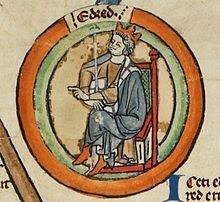
955 King Eadred brought Northumbria permanently under English rule.

1034 Máel Coluim mac Cináeda, King of Scots died. Donnchad, the son of his daughter Bethóc and Crínán of Dunkeld, inherited the throne.
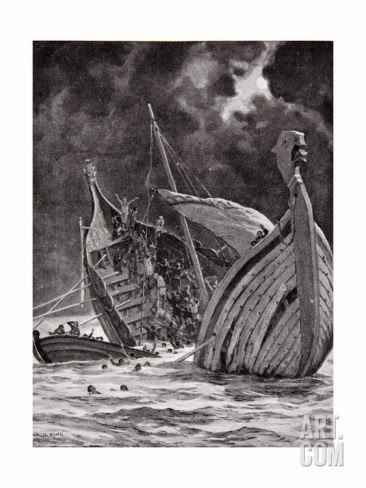
1120 The White Ship sank in the English Channel, drowning William Adelin, son of Henry I of England.

1177 Baldwin IV of Jerusalem and Raynald of Chatillon defeated Saladin at the Battle of Montgisard.
 1343 a tsunami, caused by an earthquake in the Tyrrhenian Sea, devastated Naples (Italy) and the Maritime Republic of Amalfi.
1343 a tsunami, caused by an earthquake in the Tyrrhenian Sea, devastated Naples (Italy) and the Maritime Republic of Amalfi.
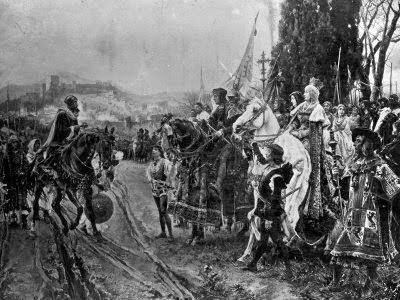
1491 The siege of Granada, the last Moorish stronghold in Spain, began.


955 King Eadred brought Northumbria permanently under English rule.

1034 Máel Coluim mac Cináeda, King of Scots died. Donnchad, the son of his daughter Bethóc and Crínán of Dunkeld, inherited the throne.

1120 The White Ship sank in the English Channel, drowning William Adelin, son of Henry I of England.

1177 Baldwin IV of Jerusalem and Raynald of Chatillon defeated Saladin at the Battle of Montgisard.
 1343 a tsunami, caused by an earthquake in the Tyrrhenian Sea, devastated Naples (Italy) and the Maritime Republic of Amalfi.
1343 a tsunami, caused by an earthquake in the Tyrrhenian Sea, devastated Naples (Italy) and the Maritime Republic of Amalfi. 
1491 The siege of Granada, the last Moorish stronghold in Spain, began.

Published on November 25, 2014 04:20
November 24, 2014
1,700-Year-Old Silk Road Cemetery Contains Mythical Carvings
by Owen Jarus
Live Science

 A cemetery dating back around 1,700 years has been discovered in Kucha, a city in China. The city played an important role along the Silk Road trade routes that connected China to the Roman Empire. Archaeologists have uncovered 10 tombs in the cemetery, seven of which are large structures made with bricks. This image shows part of the cemetery facing north.
A cemetery dating back around 1,700 years has been discovered in Kucha, a city in China. The city played an important role along the Silk Road trade routes that connected China to the Roman Empire. Archaeologists have uncovered 10 tombs in the cemetery, seven of which are large structures made with bricks. This image shows part of the cemetery facing north.
Credit: Chinese Cultural Relics
A cemetery dating back roughly 1,700 years has been discovered along part of the Silk Road, a series of ancient trade routes that once connected China to the Roman Empire.
The cemetery was found in the city of Kucha, which is located in present-day northwest China. Ten tombs were excavated, seven of which turned out to be large brick structures.
One tomb, dubbed "M3," contained carvings of several mythical creatures, including four that represent different seasons and parts of the heavens: the White Tiger of the West, the Vermilion Bird of the South, the Black Turtle of the North and the Azure Dragon of the East. [See photos of the ancient Silk Road cemetery]
The M3 tomb also "consists of a burial mound, ramp, sealed gate, tomb entrance, screen walls, passage, burial chamber and side chamber" the researchers wrote in a report published recently in the journal Chinese Cultural Relics.
The cemetery was first found in July 2007 and was excavated by the Xinjiang Institute of Cultural Relics and Archaeology, with assistance from local authorities. The research team, led by Zhiyong Yu, director of the Xinjiang Archaeological Institute, published the findings in Chinese in the journal Wenwu. The article was recently translated into English and published in the journal Chinese Cultural Relics.
Who was buried here?
The identity of the people buried in the cemetery is a mystery. The cemetery had been robbed in the past and no writing was found that indicates the names of those buried or their positions in life.
The seven large brick tombs were likely constructed for people of wealth, the researchers said.
But, when the skeletal remains were analyzed, the researchers found that the tombs had been reused multiple times. Some of the tombs contain more than 10 occupants, and the "repeated multiple burials warrant further study," the researchers wrote.
City on the Silk Road
The excavators think the cemetery dates back around 1,700 years, to a time when Kucha was vital to controlling the Western Frontiers (Xiyu) of China. Since the Silk Road trade routes passed through the Western Frontiers, control of this key region was important to China’s rulers.
"In ancient times, Kucha was called Qiuci in Chinese literature. It was a powerful city-state in the oasis of the Western Frontiers" the researchers wrote.
For the dynasties that flourished in China around 1,700 years ago "the conquest and effective governance of Kucha would enable them to control all the oasis city-states in the Western Frontiers," the researchers said.
In fact, one ancient saying was, "if you have Kucha, only one percent of the states in the Western Frontiers remain unsubmissive."
Chinese Cultural Relics is a new journal that translates Chinese-language articles, originally published in the journal Wenwu, into English. The discovery of the 1,700-year-old cemetery was included in its inaugural issue.

Live Science

 A cemetery dating back around 1,700 years has been discovered in Kucha, a city in China. The city played an important role along the Silk Road trade routes that connected China to the Roman Empire. Archaeologists have uncovered 10 tombs in the cemetery, seven of which are large structures made with bricks. This image shows part of the cemetery facing north.
A cemetery dating back around 1,700 years has been discovered in Kucha, a city in China. The city played an important role along the Silk Road trade routes that connected China to the Roman Empire. Archaeologists have uncovered 10 tombs in the cemetery, seven of which are large structures made with bricks. This image shows part of the cemetery facing north.Credit: Chinese Cultural Relics
A cemetery dating back roughly 1,700 years has been discovered along part of the Silk Road, a series of ancient trade routes that once connected China to the Roman Empire.
The cemetery was found in the city of Kucha, which is located in present-day northwest China. Ten tombs were excavated, seven of which turned out to be large brick structures.
One tomb, dubbed "M3," contained carvings of several mythical creatures, including four that represent different seasons and parts of the heavens: the White Tiger of the West, the Vermilion Bird of the South, the Black Turtle of the North and the Azure Dragon of the East. [See photos of the ancient Silk Road cemetery]
The M3 tomb also "consists of a burial mound, ramp, sealed gate, tomb entrance, screen walls, passage, burial chamber and side chamber" the researchers wrote in a report published recently in the journal Chinese Cultural Relics.
The cemetery was first found in July 2007 and was excavated by the Xinjiang Institute of Cultural Relics and Archaeology, with assistance from local authorities. The research team, led by Zhiyong Yu, director of the Xinjiang Archaeological Institute, published the findings in Chinese in the journal Wenwu. The article was recently translated into English and published in the journal Chinese Cultural Relics.
Who was buried here?
The identity of the people buried in the cemetery is a mystery. The cemetery had been robbed in the past and no writing was found that indicates the names of those buried or their positions in life.
The seven large brick tombs were likely constructed for people of wealth, the researchers said.
But, when the skeletal remains were analyzed, the researchers found that the tombs had been reused multiple times. Some of the tombs contain more than 10 occupants, and the "repeated multiple burials warrant further study," the researchers wrote.
City on the Silk Road
The excavators think the cemetery dates back around 1,700 years, to a time when Kucha was vital to controlling the Western Frontiers (Xiyu) of China. Since the Silk Road trade routes passed through the Western Frontiers, control of this key region was important to China’s rulers.
"In ancient times, Kucha was called Qiuci in Chinese literature. It was a powerful city-state in the oasis of the Western Frontiers" the researchers wrote.
For the dynasties that flourished in China around 1,700 years ago "the conquest and effective governance of Kucha would enable them to control all the oasis city-states in the Western Frontiers," the researchers said.
In fact, one ancient saying was, "if you have Kucha, only one percent of the states in the Western Frontiers remain unsubmissive."
Chinese Cultural Relics is a new journal that translates Chinese-language articles, originally published in the journal Wenwu, into English. The discovery of the 1,700-year-old cemetery was included in its inaugural issue.

Published on November 24, 2014 15:46
Aerial laser discovers ancient Roman gold mines
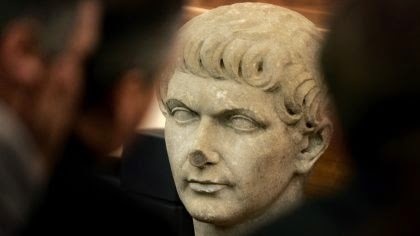 File photo of marble head statue representing Roman emperor Trajan. (REUTERS/Alessia Pierdomenico)
File photo of marble head statue representing Roman emperor Trajan. (REUTERS/Alessia Pierdomenico)Researchers in Spain have used sophisticated aerial laser technology to confirm the existence of ancient Roman gold mines.
The team from the University of Salamanca discovered the mines in the province of León in northwestern Spain, according to ScienceDaily. The researchers used an airborne laser technology called Light Detection and Ranging (LiDAR) to locate the mine complex, which was built 2,000 years ago.
LiDAR, which employs pulsed laser light to measure distances to earth, is used for a host of applications, including shoreline mapping and hydrographic surveys.
ScienceDaily reports that the gold mining complex in the Eria river valley includes sophisticated hydraulic works diverting river water to the mines. The Las Médulas region in León is considered to be the largest opencast mine in the Roman Empire but the University team discovered that mining extended many miles to the south east to the Eria valley.
"The volume of earth exploited is much greater than previously thought and the works performed are impressive, having achieved actual river captures, which makes this valley extremely important in the context of Roman mining in the north-east of the Iberian Peninsula," said Javier Fernández Lozano, geologist at the University of Salamanca and co-author of a study on the mines published in the Journal of Archaeological Science.
Fernández Lozano also described the crucial role played by LiDAR technology in locating the mine. "Unlike traditional aerial photography, this airborne laser detection system allows the visualisation of archaeological remains under vegetation cover or intensely ploughed areas."
LiDAR is an extremely useful tool for archaeologists. Last year, for example, researchers used the technology to discover lost temples, roads and hydraulic systems at Cambodia's ancient Angkor Wat site.
NASA, which developed LiDAR in the sixties, plans to use the technology to map the earth’s forests in 3D. The technology is used in a new laser instrument called Global Ecosystem Dynamics Investigation (GEDI), which has been developed for the International Space Station.
Fox News

Published on November 24, 2014 15:38
Book Launch - Scribbler Tales (Volume Two) by Mary Ann Bernal now available on Amazon
 “Scribbler Tales is a unique mix of genres in one anthology rich with tension, humanity and genuine emotion. Unconventional settings and unexpected twists are bound to leave you pondering long after you close this book.”
“Scribbler Tales is a unique mix of genres in one anthology rich with tension, humanity and genuine emotion. Unconventional settings and unexpected twists are bound to leave you pondering long after you close this book.” Madeline’s personal feelings clouds her judgment in Broken Promises where she must choose between love and obeying the law. When the guilty walk, a vigilante executes the criminals in Deception. Endgame finds a government researcher running for her life after discovering a horrific CIA secret in the isolated facility. A modern day Don Juan’s life is turned upside down in Malice when he is falsely accused of rape. In The Portrait, Holliday is obsessed with a formidable ancestor whose spirit wishes to possess her soul.
Amazon US
Amazon UK

Published on November 24, 2014 04:42



